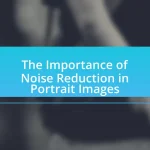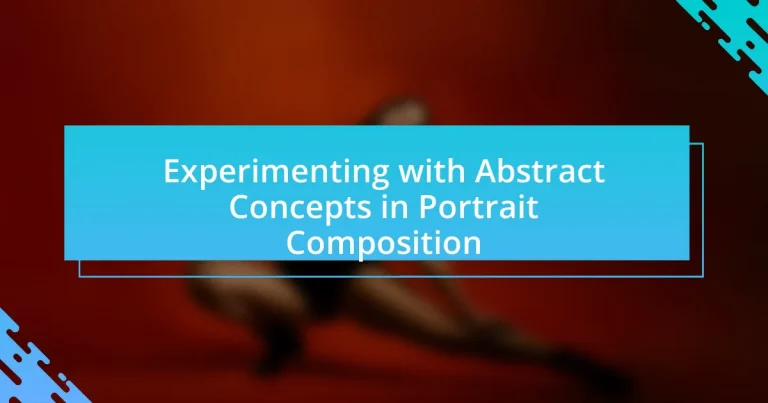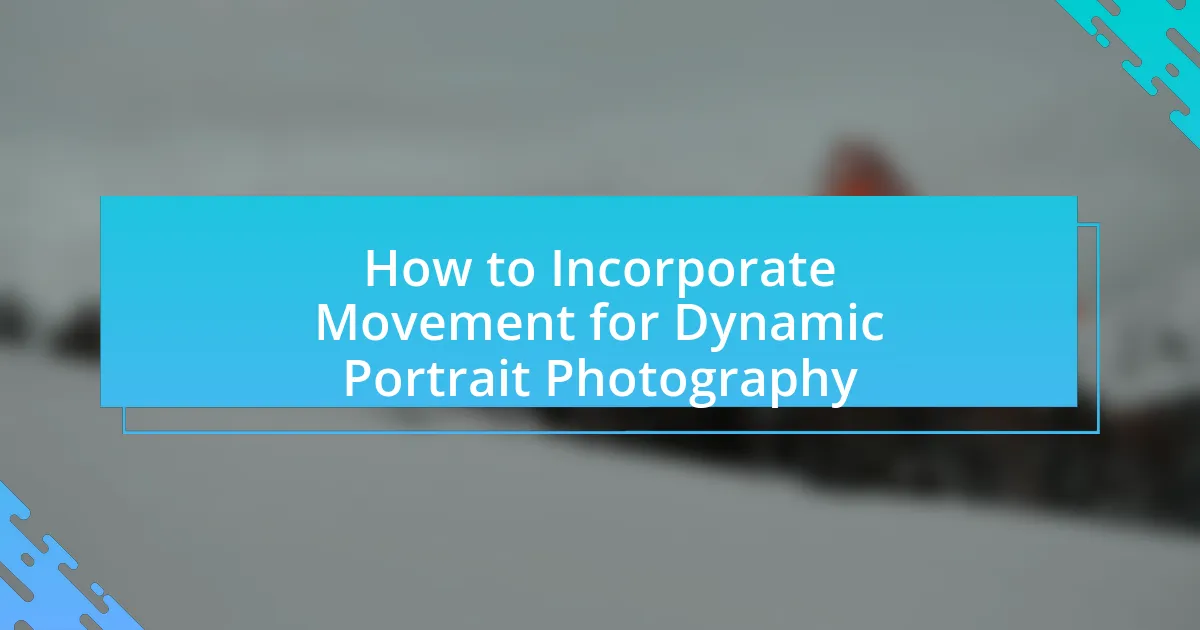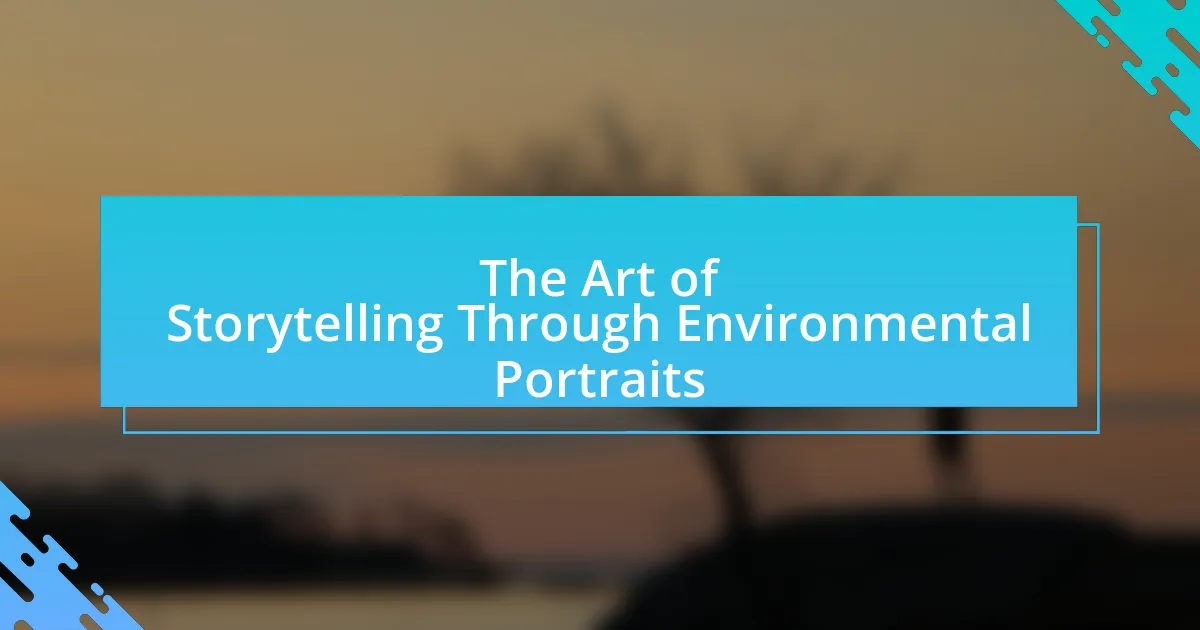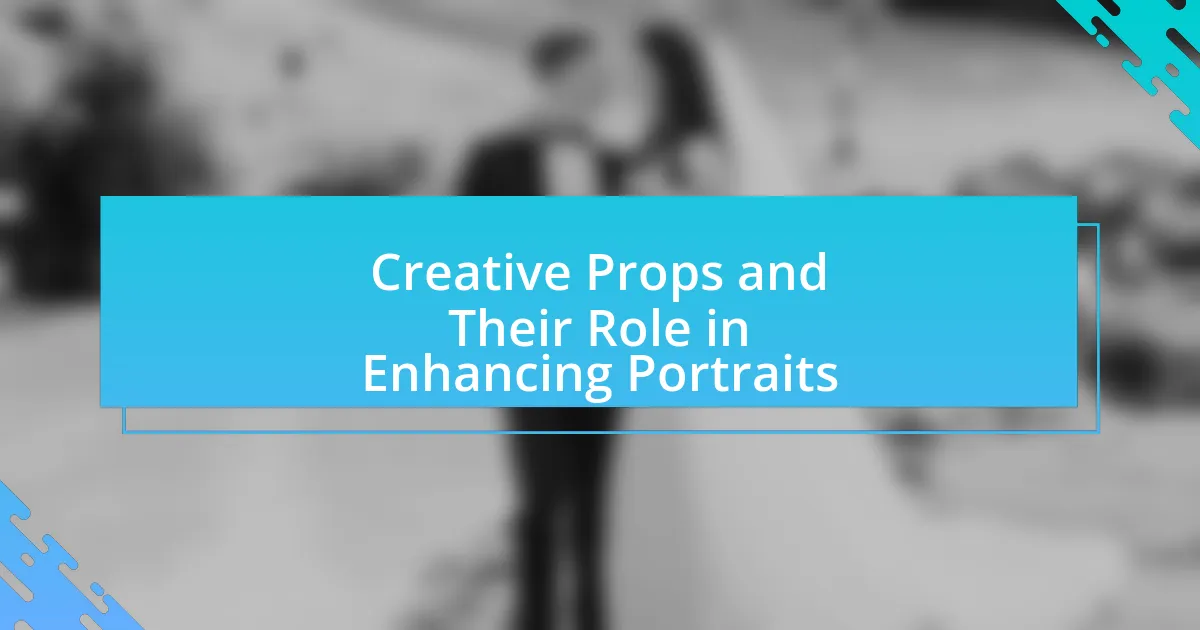The article focuses on the exploration of abstract concepts in portrait composition, emphasizing their role in shaping emotional and thematic elements within photographic works. It discusses key concepts such as balance, contrast, emphasis, unity, and movement, and how these influence viewer perception and engagement. Techniques for experimentation, including lighting manipulation and compositional strategies, are outlined, along with the challenges and pitfalls photographers may encounter. The importance of feedback and critique in refining abstract approaches is also highlighted, providing practical tips for successfully integrating abstract concepts into portrait photography.
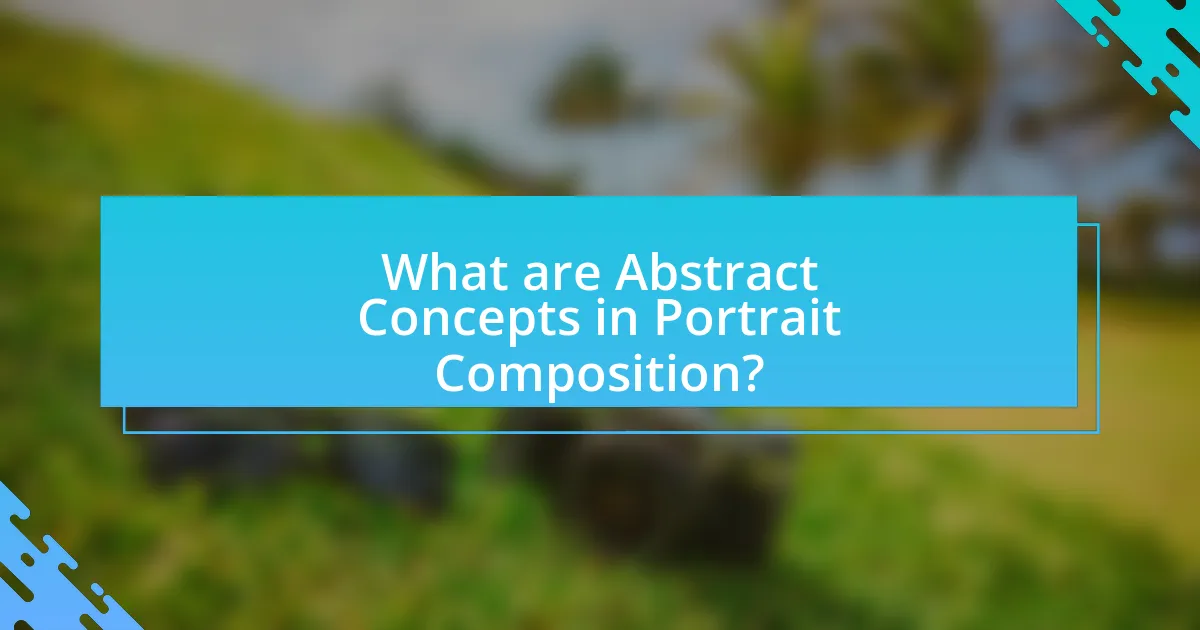
What are Abstract Concepts in Portrait Composition?
Abstract concepts in portrait composition refer to the underlying ideas and themes that influence the arrangement and presentation of subjects within a portrait. These concepts include elements such as emotion, identity, and narrative, which guide the photographer’s choices in framing, lighting, and subject placement. For instance, the use of negative space can evoke feelings of isolation or introspection, while color schemes can convey mood and atmosphere. Understanding these abstract concepts allows artists to create more impactful and meaningful portraits that resonate with viewers on a deeper level.
How do abstract concepts influence portrait composition?
Abstract concepts influence portrait composition by guiding the emotional and thematic elements that shape the visual narrative. For instance, concepts such as identity, memory, and perception can dictate the choice of colors, forms, and spatial arrangements within the portrait. Artists often utilize these abstract ideas to evoke specific feelings or to challenge viewers’ interpretations, thereby enhancing the depth and meaning of the artwork. Research indicates that portraits that incorporate abstract elements tend to resonate more profoundly with audiences, as they invite personal reflection and engagement, thus demonstrating the significant impact of abstract concepts on artistic expression.
What are the key abstract concepts commonly used in portrait composition?
The key abstract concepts commonly used in portrait composition include balance, contrast, emphasis, unity, and movement. Balance refers to the distribution of visual weight in a portrait, ensuring that no single element overwhelms the composition. Contrast highlights differences in color, tone, or texture, drawing attention to specific areas. Emphasis directs the viewer’s focus to the subject, often achieved through positioning or lighting. Unity creates a cohesive look by harmonizing elements within the portrait, while movement guides the viewer’s eye through the composition, enhancing engagement. These concepts are foundational in creating visually compelling portraits that effectively communicate the intended message.
How can abstract concepts alter the perception of a portrait?
Abstract concepts can significantly alter the perception of a portrait by influencing the viewer’s emotional response and interpretation of the subject. For instance, the use of color, form, and composition can evoke feelings of nostalgia, tension, or serenity, thereby shaping how the subject is perceived. Research indicates that abstract elements, such as non-representational shapes or unconventional color palettes, can lead viewers to engage with the portrait on a more conceptual level, prompting them to consider themes like identity, emotion, or societal commentary. This shift in focus from the literal representation to the underlying ideas can transform a straightforward portrait into a complex narrative, altering the viewer’s understanding and appreciation of the artwork.
Why is experimenting with abstract concepts important in portrait photography?
Experimenting with abstract concepts is important in portrait photography because it allows photographers to explore new perspectives and emotional depths, enhancing the storytelling aspect of their work. By incorporating elements such as color, shape, and form, photographers can create images that evoke feelings and provoke thought, moving beyond traditional representations of subjects. This approach has been validated by studies showing that abstract imagery can engage viewers more effectively, as seen in the work of artists like Francis Bacon, who utilized abstraction to convey complex human emotions.
What creative opportunities arise from experimenting with abstract concepts?
Experimenting with abstract concepts in portrait composition opens up opportunities for innovative expression and unique visual storytelling. By breaking away from traditional representations, artists can explore themes such as identity, emotion, and perception through non-literal forms. This approach allows for the integration of diverse elements like color, shape, and texture, which can evoke deeper emotional responses and challenge viewers’ interpretations. For instance, the use of abstraction can lead to the creation of portraits that reflect the complexity of human experience, as seen in the works of artists like Pablo Picasso, who utilized abstract forms to convey multifaceted identities. Such experimentation not only enhances creativity but also encourages dialogue about the nature of representation in art.
How does experimentation enhance a photographer’s skill set?
Experimentation enhances a photographer’s skill set by allowing them to explore new techniques, styles, and perspectives, which fosters creativity and technical proficiency. Engaging in various photographic experiments, such as manipulating lighting, composition, and subject matter, enables photographers to discover their unique voice and improve their ability to convey emotions and narratives through images. Studies have shown that photographers who regularly experiment with their craft develop a deeper understanding of visual storytelling and technical execution, leading to more compelling and innovative work.

What Techniques Can Be Used to Experiment with Abstract Concepts?
Techniques to experiment with abstract concepts include visual metaphors, juxtaposition, and abstraction through simplification. Visual metaphors allow artists to convey complex ideas by representing them through relatable imagery, enhancing viewer understanding. Juxtaposition involves placing contrasting elements together to highlight differences and provoke thought, which can lead to deeper interpretations of the subject matter. Abstraction through simplification strips away unnecessary details, focusing on essential forms and colors, thereby encouraging viewers to engage with the underlying concepts rather than the literal representation. These techniques are widely recognized in art theory, as seen in the works of artists like Pablo Picasso and Wassily Kandinsky, who effectively utilized these methods to explore and communicate abstract ideas.
How can lighting be manipulated to create abstract effects in portraits?
Lighting can be manipulated to create abstract effects in portraits by altering its direction, intensity, and color. For instance, using side lighting can cast dramatic shadows that distort facial features, enhancing the abstract quality of the image. Additionally, low-intensity lighting can create a soft, ethereal effect, while colored gels can introduce unexpected hues that shift the viewer’s perception. Studies in photography demonstrate that these techniques can evoke emotions and challenge traditional representations, as seen in the works of artists like Man Ray, who utilized unconventional lighting to produce surreal and abstract portraits.
What types of lighting setups are most effective for abstract portraiture?
The most effective lighting setups for abstract portraiture include high-contrast lighting, soft diffused lighting, and colored gels. High-contrast lighting creates dramatic shadows and highlights, enhancing the abstract qualities of the subject. Soft diffused lighting, achieved through softboxes or reflectors, provides a gentle illumination that can soften features and create an ethereal effect. Colored gels can be used to cast vibrant hues on the subject, adding a layer of abstraction and emotional depth. These setups allow for creative expression and experimentation, which are essential in abstract portraiture.
How does the direction and quality of light impact abstract concepts?
The direction and quality of light significantly influence abstract concepts in portrait composition by shaping mood, perception, and emotional resonance. Directional light creates shadows and highlights that can evoke feelings of drama or tranquility, while soft, diffused light often conveys gentleness or intimacy. For instance, Rembrandt lighting, characterized by a specific angle and quality, can enhance the subject’s features and create a sense of depth, thereby impacting the viewer’s emotional response. Studies in visual perception indicate that lighting conditions can alter the interpretation of a subject’s expression, reinforcing the idea that light is not merely a technical element but a vital component in conveying abstract themes in art.
What role does composition play in abstract portrait experimentation?
Composition plays a crucial role in abstract portrait experimentation by determining the arrangement of visual elements that convey emotion and meaning. In abstract portraits, composition influences how viewers perceive the subject, guiding their focus and interpretation through the use of balance, contrast, and spatial relationships. For instance, the placement of shapes and colors can evoke specific feelings or highlight particular aspects of identity, as seen in the works of artists like Pablo Picasso, who utilized fragmented forms to challenge traditional representations of the human figure. This strategic arrangement not only enhances the aesthetic appeal but also deepens the conceptual engagement of the viewer with the artwork.
How can framing and angles contribute to abstract interpretations?
Framing and angles significantly influence abstract interpretations by altering the viewer’s perception and emotional response to the subject. The choice of framing can isolate elements within a composition, emphasizing certain features while minimizing others, which can lead to varied interpretations of the same subject. For instance, a close-up framing may evoke intimacy or tension, while a wide-angle shot can create a sense of isolation or vastness. Additionally, angles can distort reality; a low angle may empower the subject, while a high angle can diminish it, thus shaping the narrative conveyed through the portrait. Research in visual perception indicates that these compositional choices directly affect how viewers engage with and interpret visual art, reinforcing the idea that framing and angles are crucial tools in abstract representation.
What compositional rules can be bent or broken for abstract effects?
Compositional rules that can be bent or broken for abstract effects include the rule of thirds, balance, and perspective. The rule of thirds, which typically guides the placement of subjects along grid lines, can be disregarded to create tension or focus on a singular element. Balance, often achieved through symmetrical arrangements, can be altered to evoke unease or dynamism by intentionally creating asymmetry. Perspective, which usually dictates the viewer’s point of view, can be manipulated by using extreme angles or unconventional framing to challenge perceptions and enhance abstraction. These deviations allow artists to explore new visual narratives and emotional responses in portrait composition.

What Are the Challenges of Experimenting with Abstract Concepts?
Experimenting with abstract concepts presents challenges such as difficulty in measurement and evaluation. Abstract concepts, by nature, lack concrete definitions, making it hard to quantify their impact on portrait composition. For instance, concepts like “emotion” or “identity” can vary widely in interpretation, leading to inconsistencies in how they are applied in artistic practice. Additionally, the subjective nature of abstract concepts can result in varied responses from viewers, complicating the assessment of artistic effectiveness. Research indicates that artists often struggle to convey abstract ideas clearly, which can hinder communication and understanding of their work.
What common pitfalls should photographers avoid when experimenting?
Photographers should avoid the common pitfalls of overcomplicating their compositions, neglecting technical fundamentals, and failing to plan their experiments. Overcomplicating compositions can lead to confusion and distract from the subject, as seen in studies where simpler designs yield more impactful images. Neglecting technical fundamentals, such as exposure and focus, can result in poor-quality images, which undermines the experimental process. Additionally, failing to plan can lead to wasted time and resources, as spontaneous decisions often lack coherence and direction, making it difficult to achieve desired outcomes.
How can overcomplication detract from the intended message of a portrait?
Overcomplication can detract from the intended message of a portrait by obscuring the subject’s essence and emotional impact. When a portrait includes excessive details, intricate backgrounds, or convoluted symbolism, it can distract viewers from the primary focus, which is often the subject’s expression and personality. Research indicates that simplicity in art enhances viewer engagement and comprehension, as seen in studies on visual perception that show people process clear, straightforward images more effectively than complex ones. Therefore, maintaining clarity in composition is crucial for conveying the intended message of a portrait.
What strategies can help maintain focus on the subject while experimenting?
To maintain focus on the subject while experimenting with abstract concepts in portrait composition, one effective strategy is to establish clear objectives for each experiment. Defining specific goals, such as exploring lighting, angles, or color palettes, helps direct attention and minimizes distractions. Research indicates that goal-setting enhances focus and performance, as demonstrated in a study by Locke and Latham (2002), which found that specific and challenging goals lead to higher performance levels. Additionally, using a consistent framing technique, such as adhering to the rule of thirds, can help keep the subject prominent in the composition, ensuring that the experimentation does not detract from the main focus.
How can feedback and critique improve abstract portrait experimentation?
Feedback and critique can significantly enhance abstract portrait experimentation by providing diverse perspectives that challenge the artist’s vision. When artists receive constructive criticism, they can identify strengths and weaknesses in their work, leading to more informed decisions in their creative process. For instance, feedback can highlight areas where the use of color, form, or composition may not effectively convey the intended emotion or concept, prompting the artist to explore alternative approaches. Research indicates that peer review in artistic practices fosters innovation and skill development, as artists refine their techniques based on external input. This iterative process of receiving and applying feedback ultimately leads to more dynamic and engaging abstract portraits.
What are effective ways to seek constructive feedback on abstract portraits?
To seek constructive feedback on abstract portraits, artists should engage with specific audiences, such as art critique groups or online forums dedicated to abstract art. These platforms provide targeted insights from individuals familiar with abstract concepts, enhancing the quality of feedback. Additionally, artists can request feedback by asking specific questions about elements like color use, composition, and emotional impact, which encourages detailed responses. Research indicates that structured feedback requests lead to more actionable insights, as noted in studies on art critique methodologies. Engaging with diverse perspectives, including those from non-artists, can also yield unique interpretations that enrich the artist’s understanding of their work.
How can critique help refine the use of abstract concepts in future work?
Critique can refine the use of abstract concepts in future work by providing targeted feedback that identifies strengths and weaknesses in the application of those concepts. This feedback allows creators to understand how effectively their abstract ideas resonate with audiences, leading to adjustments that enhance clarity and impact. For instance, critiques can reveal whether the intended emotional or thematic messages are conveyed through visual elements, thus guiding artists to modify their approach based on audience perception and engagement. Research indicates that iterative feedback processes significantly improve creative outcomes, as seen in studies on collaborative art practices, where artists who actively seek critique produce more refined and cohesive works.
What are some practical tips for successfully experimenting with abstract concepts in portrait composition?
To successfully experiment with abstract concepts in portrait composition, photographers should focus on manipulating elements such as light, color, and form to evoke emotions and convey deeper meanings. For instance, using dramatic lighting can create strong contrasts that emphasize the subject’s features, while unconventional color palettes can alter the mood of the portrait. Additionally, incorporating abstract shapes or patterns in the background can enhance the overall composition and draw attention to the subject. Research indicates that visual elements significantly impact viewer perception, as demonstrated in studies on color psychology, which show that colors can evoke specific emotional responses. Therefore, by thoughtfully combining these elements, photographers can create compelling and thought-provoking portraits that resonate with viewers.





